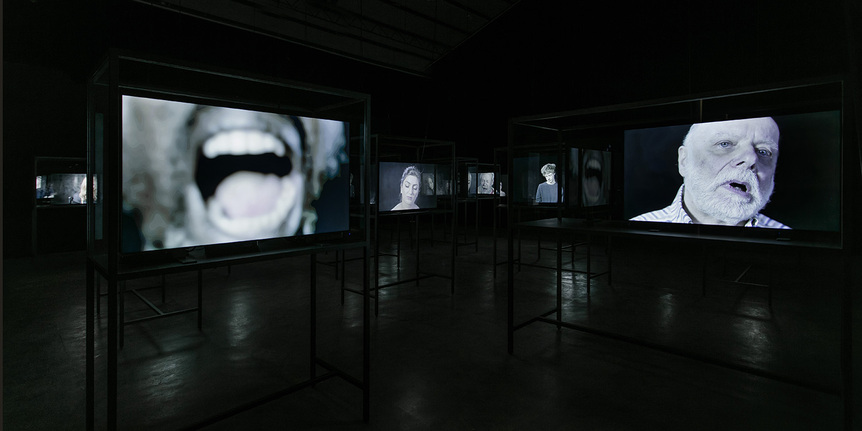-
From Current Issue
-
- Editor’s Letter Fire in the Heart
- Reviews I Gusti Ayu Kadek Murniasih
- Reviews 11th Seoul Mediacity Biennale: “One Escape at a Time”
- Dispatch Networked China
- One on One Monira Al Qadiri on Yukio Mishima
- Essays The rise of independent art spaces in pandemic-era Shanghai
- Features Tuan Andrew Nguyen
- Table of Contents
- Web Exclusives
- Archive
- Subscribe

R
E
V N
E
X
T
Recent years have seen Liaoning-born He Xiangyu emerge as a rising star of the fast-paced and fickle world of Chinese contemporary art. With a string of solo exhibitions at international galleries and institutions to his name, as well as participation in group showcases including the film program held in conjunction with the exhibition “Tales of Our Time” (2016) at the Solomon R. Guggenheim Museum, and the 13th Biennale de Lyon (2015), the young artist’s presence has been unfaltering since graduating from Shenyang Normal University in 2008. Known for conceptual installations addressing cultural and social concerns in today’s China, He’s recent work has taken an introspective turn, as witnessed by his latest Shanghai exhibition, “Turtle, Lion and Bear.”
The exhibition was one of several shows to open at Shanghai’s West Bund cultural district in the lead up to Art Basel Hong Kong. The venue, Qiao Space, points to the significant clout of a handful of collectors who are shaping the city’s art scene. The recently built private exhibition space of collector Qiao Zhibing will soon be joined by his ambitious cultural park, Tank Shanghai, slated to open later this year.
For He’s show, which was organized in partnership with White Cube gallery, Qiao Space’s huge sliding doors were given a not-so-mellow yellow makeover to match the startling hue of the show’s centerpiece, 121 Lemons (2016). An extension of He’s recent “Lemon Flavored” series (2014–16), his ongoing body of work “Lemon Paintings” (2016– ) sees citrus-shaped blank spaces punctuate otherwise saturated canvases. Deceptively simple, the shapes’ arrangement tricks the eye, making the fruits appear to jostle and jump. Presented alongside these pieces were works on paper comprising He’s notes, sketches and studies for the larger paintings, exploring everything from how tone and angle influence visual perception, to the effect created by square-shaped as opposed to rectangular surfaces. “Lemon Paintings” plays on our cognition and physical senses to prompt two distinct physiological reactions. The artwork is visually disruptive—despite its apparent simplicity, 121 Lemons is genuinely jarring to look at thanks to its spatial arrangement of citrus-suggestive spaces and narrow tonal spectrum. It is not an entirely comfortable experience. To a lesser extent, the work also plays on the gustatory, prompting in some a sudden acidic taste in the mouth in an effect not unlike that of synesthesia.
Installation view of HE XIANGYU’s “Turtle, Lion and Bear” at Qiao Space, Shanghai, 2017. Courtesy the artist and White Cube.
Hidden behind heavy velvet curtains, Turtle, Lion and Bear (2015) comprises a maze of 25 video screens showing 21 humans (He included) and the three titular animals, all yawning. Created for the Biennale de Lyon in 2015, its presentation at Qiao Space was its first China outing. Through the oddly contagious action of yawning, Turtle, Lion and Bear creates a physical chain reaction that links artist, artwork and viewer. Furthermore, the work revealed that behaviors associated with yawning are not just infectious, they’re also deeply engrained: speaking prior to the exhibition’s opening, he explained that for most participants, not covering their mouth was deeply counterintuitive. Whether triggered by tiredness, stress, hunger or the subliminal influence of others, there is something vulnerable about yawning.
Markedly different in scale and scope from He’s early, more outward-looking works, most notably Cola Project (2009–10) and Tank (2011–13), which point to the influence of Western-style materialism on contemporary China through the ubiquitous soft drink and handcrafted leather, respectively—“Lemon Paintings” and Turtle, Lion and Bear take a more individualistic approach, furthering the artist’s investigations into the correlation between visual cues and physiological responses. The catalyst for this shift in perspective was He’s frustration at being unable to communicate while on a previous trip to the United States. Aware of the need not only to train his brain to think in English, but also his tongue to pronounce English, He turned his attention to the landscape of ridges and bumps at the top of his mouth. The experience resulted in the work Everything We Create is Not Ourselves (2013), which much like braille, saw He “translate” his palate into tactile copper casts. Handling the objects prompts the viewer to instinctively explore the roof of their own mouth with the tip of the tongue.
“Turtle, Lion and Bear” is at once a study in phenomenology, a challenge, and an open invitation to participate in a shared experience. By tapping into the primal and instinctive, He confronts dissonance between the cognitive and the physiological, and in doing so, draws common denominators between individuals.
He Xiangyu’s “Turtle, Lion and Bear” is on view at Qiao Space, Shanghai, until June 8, 2017.
To read more of ArtAsiaPacific’s articles, visit our Digital Library.







